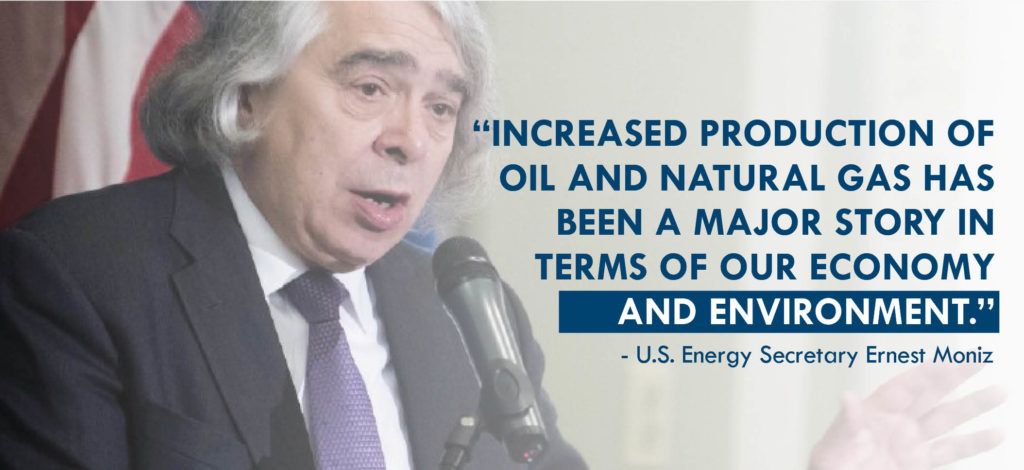As top athletes compete at this summer’s Rio Olympics, American shale development continues to deliver gold for our nation’s economy, our environment and our security. The U.S. is a world leader in energy production with domestic shale driving worldwide production growth and outpacing former energy powerhouses like Russia and Saudi Arabia. In fact, American oil and gas production is on track to double by 2040, according to federal data, thanks to advancements in horizontal drilling as well as hydraulic fracturing.
At the same time, while consumers, families, small businesses and manufacturers continue to benefit from more affordable homegrown energy, our nation’s environment and air quality is sharply improving as more natural gas is used to power and grow our economy. To be sure, America’s GHG emissions have been driven to record lows – a reduction greater than any other country – and carbon emissions are lower than they have been in 24 years, according to EIA.

Here’s what they’re saying about abundant, domestic clean-burning natural gas:
- President Obama’s Top Energy Advisor: “Fracking has been good for the environment”: The oil and gas boom is reducing U.S. GHG emissions, Energy Sec. Ernest Moniz said. … “The increased production of oil and natural gas in the U.S. has, obviously, been a major story in terms of our economy, and also our environment. … The natural gas boom, in particular, has led to … fewer [carbon dioxide] emissions,” Moniz said. Moniz’s comments follow those by the head of the EIA the Energy Department’s analysis arm, indicating that carbon emissions are lower than they have been since 1992 because of increased reliance on natural gas from hydraulic fracturing. … [Washington Democratic Sen. Maria Cantwell] said the oil and gas boom has achieved “energy independence” in making the nation less dependent on foreign oil. “This is a pretty big shift for the U.S. … We wanted energy independence. But now we got it.” (Washington Examiner, 8/15/16)
- EIA: Fracking Drives Air Quality Improvements: Reports published by the EIA found that fracking is the primary reason for the decline in American CO2 emissions. … EPA has noted that rising natural gas use is responsible for falling GHG emissions. … Fracking, not government green policies, caused CO2 emissions to drop sharply in 47 states and Washington, D.C., in 2015, according to both Scientific American and EIA reports. Fracking cut more CO2 emissions than solar or wind power, according to a study published by the Manhattan Institute. The study shows solar power is responsible for 1% of the decline in American CO2 emissions, while natural gas is responsible for nearly 20%. For every ton of CO2 cut by solar, fracking cuts 13. … The 75 scientific studies published over the last five years found that methane emissions from the natural gas industry are sharply falling, even though production of natural gas has spiked. Absolute methane emissions from natural gas fell by 15% between 1990 and 2014, and emissions per unit of natural gas produced dropped by 43% over the same period. (Daily Caller, 8/16/16)
- Clean-Burning Natural Gas Key to America’s Energy Future: It is possible to support both natural gas and renewable energy sources, which work hand-in-hand to provide a diverse mix of reliable American energy. … Natural gas-fired power plants are highly efficient, able to quickly come online and use a fuel that we have in abundance in Pa. For those concerned about open space, natural gas units use a fraction of the land area that solar arrays and wind farms consume. … Pa. natural gas, delivered by the PennEast Pipeline, is a key component of the region’s clean energy revolution. (Morning Call column, 8/15/16)
- We Are Family: Renewables and Natural Gas Work Together: We all want cleaner burning fuel and lower CO2 emissions, but wind, solar and other renewables are only getting us so far. Natural gas is the next logical step … It is safe, inexpensive and has helped reduce carbon monoxide emissions. Moreover, natural gas makes renewable energy more viable. … Natural gas fits the bill in a way that other energy sources can’t. It combines both lower costs with cleaner air. Over the last 20 years, carbon emissions have been steadily decreasing and the credit in large part has been given to cleaner burning natural gas. Cleaner energy should no longer be defined only by solar and wind. Renewables and natural gas are complementing each other. (Citizens’ Voice letter, 8/12/16)
- National Bureau of Economic Research: Shale, Wind and Solar “Highly Complementary”: Because of the particular nature of clean energy sources like solar and wind, you can’t simply add them to the grid in large volumes and think that’s the end of the story. Rather, because these sources of electricity generation are “intermittent” there has to be some means of continuing to provide electricity even when they go dark. … a new [National Bureau of Economic Research] study suggests … installing a large number of fast-ramping natural gas plants, which can fill in quickly whenever renewable generation slips. … [Researchers] found a surprisingly tight relationship between renewables on the one hand, and gas on the other. “All other things equal, a 1% increase in the share of fast reacting fossil technologies is associated with a 0.88% increase in renewable generation capacity in the long term,” the study reports. … “Our paper calls attention to the fact that renewables and fast-reacting fossil technologies appear as highly complementary and that they should be jointly installed to meet the goals of cutting emissions and ensuring a stable supply,” the paper adds. The type of “fast-reacting fossil technologies” being referred to here is natural gas plants that fire up quickly. … “This allows partners to respond quickly to grid demand fluctuations, integrating renewables as necessary.” (Washington Post, 8/11/16)
For more facts, visit our blog and connect with the MSC on Facebook, Twitter and LinkedIn.




